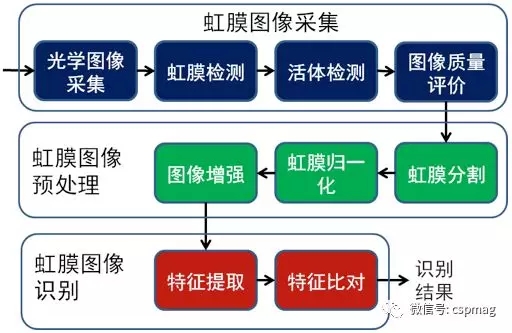The appearance of the human eye consists of the sclera, the iris and the pupil. The iris is an annular area between the sclera and the pupil, which accounts for about 65% of the total area of ​​the eye. It contains abundant texture information such as pits, radiation lines, pigment spots, and other spots. And since the age of 8 months, the iris information has become stable and no longer changes in life.
The iris recognition technology was first proposed by the ophthalmologists FLOM and SAFIR in 1987 and applied for related core patents. After the FLOM and SAFIR patents expired in 2005, the iris recognition technology at home and abroad developed rapidly. The iris identity recognition system can be roughly divided into three major links: image acquisition, preprocessing and identification. Each link also includes several steps (as shown in the figure).
The basic process of iris recognition
1. The main function of the iris image acquisition module is to acquire high-quality iris images with a friendly man-machine interface by means of photoelectric equipment. Different from human face and fingerprints, the iris is a small target object, and image acquisition is difficult. Image acquisition is the primary difficulty in iris recognition. At present, the iris recognition equipment in China mainly collects iris images in the near-infrared light (wavelength is about 850nm), and has higher requirements for the design of fill light and the degree of user cooperation. Domestic iris recognition equipment application distance is less than 60cm, depth of field up to 5 ~ 15cm, lower user-friendliness; there are applications of the iris recognition equipment in the range of 60 ~ 150cm, but the user requires a higher degree of cooperation, the cost is also Higher; iris recognition devices with a distance of more than 150cm are still in the laboratory research phase.
2. The iris image preprocessing includes iris detection, segmentation, and normalization. Iris detection refers to detecting whether the iris is present in the current input image and the position and size of the iris in the image. The iris image segmentation is the inner and outer borders of the specified iris and detects possible occluders, excluding the effects of non-iris texture image areas such as pupil, sclera, eyelids, eyelashes, spots, and the like on iris feature extraction. The iris image normalization refers to mapping different iris images from a rectangular coordinate system to a fixed-size rectangle in a polar coordinate system, so as to eliminate the effects of iris size and deformation on the recognition performance.
3. The iris image recognition module includes iris feature extraction and feature comparison, extracts robust personalized information from the normalized iris image, encodes the iris template using a format that can be stored and read by the computer, and then utilizes the iris template. Machine learning methods such as neural networks and support vector machines compare iris templates in order to achieve the final identification and verification.
Train Piston Pin, a cylindrical pin mounted on the skirt of the piston, passes through the small hole in the middle of the connecting rod and is used to connect the piston and the connecting rod, passing the gas force on the piston to the connecting rod. It is usually made of high quality alloy steel and made hollow.
Train Piston Pin materials are generally low carbon steel or low carbon alloy steel, such as 20, 20 mn, 15Cr, 20 cr or 20 MNV. The outer surface is hardened by carburizing and then refined and polished. This not only improves the surface hardness and abrasion resistance, but also ensures high strength and impact toughness.

Train Piston Pin
Train Piston Pin,Piston Pin For Train Engine,Train Diesel Engine Piston Pin,Train Spare Parts Piston Pins
Hebei Zhonghai Shipping Accessories Manufacturing Co., Ltd. , https://www.zhonghaiship.com

